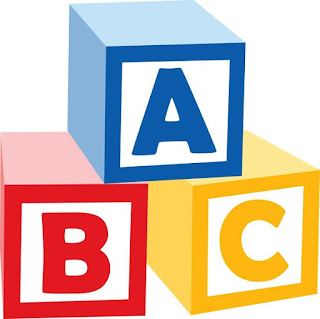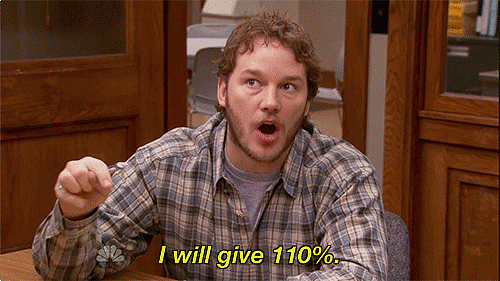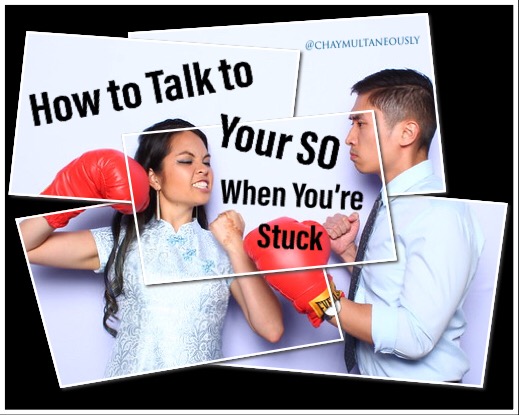A-B-Cing Change in Behavior
So you’ve tackled passive-aggressive behavior in yourself; congratulations! Welcome to a lifetime of self-reflection and endless fine tuning... Sometimes frustrating, yes, but ultimately worth it. I hope you feel like a new and shiny version of yourself.
It’s much more likely, however, that you’ll feel kind of crappy about yourself - revealing “bad” qualities in yourself is like cleaning out the bottom of your kitchen trash can - aka my LEAST favorite chore ever. It’s so easy to just throw on another trash liner and pretend that smell is going to fade with time. Cleaning off the source, however, takes effort, which includes holding my nose, fighting the urge to barf, and scraping up rotting food scraps. But when it’s over, your trash is clean - and the smell is gone. And yes, you will have to do it again and again.. And you might just be more careful about tossing your trash in the weeks to come.
********
I feel a bit irresponsible as a counselor because I started with my catchy first article but failed to go over the basics of something wildly important before I can talk about how to counter passive-aggressiveness in others.. so here goes.
The ABC’s of Behavior
For those counseling nerds out there, you’ll know that the ABC model of behavior was originally popularized by Albert Ellis; this is a foundational piece of cognitive behavioral therapy aka CBT, which is getting pretty popular in the therapy/counseling world. The basis of any behavioral therapy is this: change the behavior = change the thoughts/emotions. It might seem backwards from old fashioned therapy, which is to listen to feelings and values and THEN change behavior, but there's more than one way to climb a mountain or skin a cat as they say.
- 1) I wash my face because I feel good when it’s clean.
- 2) I don’t take out the trash because touching it and smelling it makes me sick.
- 1) ...Eventually I take out the trash because I want the smell to stop spreading beyond the trash can.
- (I just really hate the trash y’all)
The ABC model is as basic as it can get:
Antecedent → Behavior → Consequence
A = what happens before / also known as "activating" event
B = the action
C = what the person gets out of it
Everything, everything, everything that we do, aka our behavior, is motivated by the consequences that follow. If there is no consequence, we won’t continue doing it.
Let’s go real simple:
A = A friend asks me to try a bowl of ice cream.
B = I eat the ice cream.
C = The taste is pleasant and surprising.
Because the taste is a *positive* consequence, I’m definitely going to continue eating this ice cream. We call this “reinforcement”. You can imagine the opposite example:
A = A friend asks me to try celery.
B = I eat the celery.
C = The taste is unpleasant and the texture is uncomfortable.
So my behavior of eating celery is not reinforced; it’s a *negative* consequence. Easy right?
Let’s make it a tad more complicated. Bring it back to elementary school for me, since that’s where I spend most of my days.. We can meet one of my students, who simply hates math and all that it stands for. She's sitting in class when...
A = Teacher says, “Let’s take out our math books”
B = Student gets out of her desk and starts talking loudly to her friends.
C = Teacher sends her to the back of the room with a reflection sheet.
It’s hard for some of us to get this because we think that this is a ‘negative’ consequence, but this student just successfully got out of doing math, the thing she hates more than anything in the world. So this behavior was actually reinforced, and she will continue doing this behavior because the function aka the purpose of her behavior was to get out of math. She could care less about getting in trouble, or at the very least, it's way more preferable that her friends don't think she's stupid. Often I have to help teachers figure out how to set boundaries on behavior that also don’t reinforce the function of the behavior.
So how do you change the B in the equation? You tweak the A or the C.. or both! For instance, before starting math, this kid could have a job that requires them to get up and pass out papers; or she could be put in a group where they have a shared desk and math book so that they can explain concepts to each other; or when she does get up, the teacher reroutes her talking behavior to still doing math, using humor or her words as part of an example, etc. etc. It takes some creativity because every kid is different and every situation is new, but with practice, behaviors are changeable!
Finally! We got that covered.
And now, the other most difficult part of living: other people. And that pesky pass-agg.
With our new knowledge, let’s imagine this:
What to do?????
*Also, if I could only give everyone in the world one counselor tool it would be the ability to identify the feelings in other people: aka empathy! How is your friend feeling? I would guess nervous or anxious about this party, which is why he was so hurt when you said, “It doesn’t matter”. He definitely cares about something more than just this party, and he thinks having it will solve or resolve something he thinks is a problem.
2. Let them know that you’ve thought about how they might be feeling.
Using a phrase like, “I’ve been thinking a lot about how you might feel, and I am guessing you feel … (nervous, upset, mad).” Or maybe just saying, “I know you’re upset, and I want to hear about it” is sometimes enough for that door to come flying open.
Finally! We got that covered.
And now, the other most difficult part of living: other people. And that pesky pass-agg.
With our new knowledge, let’s imagine this:
One of your friends is throwing a party. He is beyond excited about it and he has been asking you for advice on what food, drinks, music, etc. he should have. You help him for a few days, and he continues texting you about it even late at night when you’re kind of over talking about it. In a moment of irritation, when he’s asking you for yet another choice between starting the party earlier in the day or after lunch, you tell him, “yeah I don’t think it matters, do whatever.” He suddenly stops sending texts, which in today’s world, could mean anything, and you're kind of relieved actually so you don’t worry about it. But in the days leading up to the party, he doesn’t say anything to you. You even try calling and he doesn’t pick up.
What to do?????
Conflict Resolution
Prep work:
*Like I said, with any of the interventions I suggest, start with Find Your Why. This will always ground you in the deeper goal. Especially with friends and family, we forget our ‘why’ and go straight into trying to win an argument or convince them at the very least that they are wrong somewhat. If you ground yourself in “why” -- that I love and care for this person, that I want our friendship to grow, that I want to understand them and know them more deeply, that I want to be a better friend and person -- then it will be like tracking ‘north’ on your compass so you always know which general direction you want to go, even if you get sidetracked.*Also, if I could only give everyone in the world one counselor tool it would be the ability to identify the feelings in other people: aka empathy! How is your friend feeling? I would guess nervous or anxious about this party, which is why he was so hurt when you said, “It doesn’t matter”. He definitely cares about something more than just this party, and he thinks having it will solve or resolve something he thinks is a problem.
1. Set up a time/place to talk in a calm space.
As we just learned, changing antecedent is a good start. Texting is how you got into this mess, so changing method of communication might help. Setting it up also provides some kind of prep time so both parties can think about how they feel and what to say. Obviously this is harder when someone is avoiding you. Things I have tried with some of my particularly passive-aggressive peeps (or things that people have tried on me that have worked when I was being pass-agg):
- Leaving them a message asking them to talk, specifying a time and/or place if in person
- Giving space for some time, then coming to check on me (oops gave it away) when I seem to have changed activities (i.e. moving from sulking in the bedroom to getting food in the kitchen)
- Asking someone else to ask them to talk (I would be careful with this one, not putting people in the middle of a conflict is always a sensible idea, but sometimes it is the only way they'll release their stubbornness)
2. Let them know that you’ve thought about how they might be feeling.
This is majorly important in counseling, but I think it’s a crucial part of conflict resolution that we never learn explicitly. It was a huuuuuge game changer for me, in particular. I was raised to be closed off to feelings of discomfort and conflict because they were hurtful. But avoiding them only made them grow. Suddenly I had a way to open the door to deeper conversation, and it seemed so silly at first - stating the obvious.. Of course I knew how they feel! But the more I did it, the more I realized: 1) I actually don’t always know how they’re feeling and 2) it feels good to hear someone say that they see your feelings. This is the change in consequence - instead of being rejected on top of feeling hurt (most passive aggressive behavior is learned this way) - they are listened to and understood and seen.
Using a phrase like, “I’ve been thinking a lot about how you might feel, and I am guessing you feel … (nervous, upset, mad).” Or maybe just saying, “I know you’re upset, and I want to hear about it” is sometimes enough for that door to come flying open.
3. Listen to their words.. AND what they're saying.
This took me awhile to craft in my counseling training but I believe everyone has full capacity to be an expert in, therapy training or not. When your friend is talking about avoiding you, for example, he could say: "it doesn't matter I don't really care anymore" but his face is averted or body language is closed or tensed. He's avoiding conflict with you by saying he doesn't care, but he is still clearly hurt. He could say, "I don't know why I got so intense about planning this party"; within a few sentences, he could be admitting that he wants this person he likes to come and he wants them to notice his effort. People unfold like flowers sometimes, and you might see one layer at a time.
4. Express your commitment to changing your behavior and let them know your needs as well.
Relationships are two way streets always. You know you can be more sensitive to your friends' feels, but at the same time, being honest with him about how intense he was about the party could have saved both of you from engaging in passive-aggressive behavior. He can be open to hearing you out and working with you too.
Damn we learned a lot today! Tune in next week for more tips from your friendly neighborhood counselor :) Thanks as always for reading!











Comments
Post a Comment